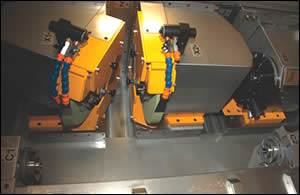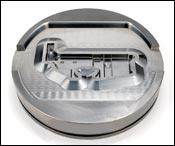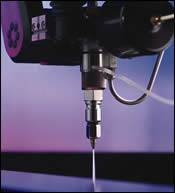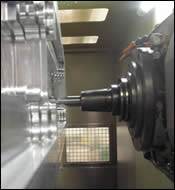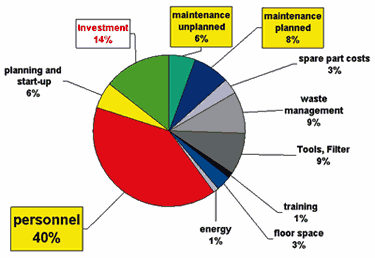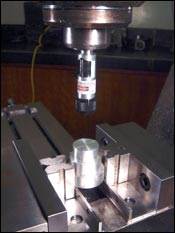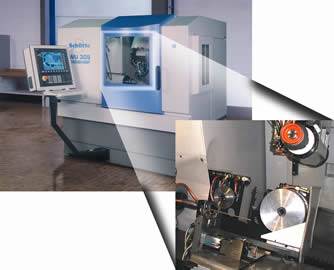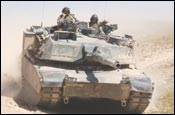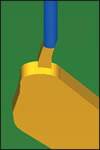Articles
Factories Around The World Consume More Equipment
China’s growth dominates the world: machine tool output & consumption survey
Read MoreHard Turning And Cylindrical Grinding Were Made For Each Other
Combining different machining processes on the same platform has been a major theme in machine tool design for two decades or so. The Studer S242 combines cylindrical grinding and hard turning. A look at this machine shows that both of these machining processes benefit when they share the same platform.
Read MoreHard Milling By The Numbers
Here are some speeds, feed rates and depths of cut for a productive hard milling process.
Read MoreIncreased Accuracy And Portability For Measuring Arms
Multi-axis, computer-aided measuring arms offer accuracy comparable to a CMM in a portable design. A new version of such an arm is said to be the first 8-foot measuring arm that can achieve an accuracy of 0.0007 inch.
Read MoreZero Taper In Abrasive Waterjet Cutting
Abrasive waterjet machines use a high-velocity beam of water and abrasive particles to cut thick materials. This "floppy tool" has a tendency to cause tapered edges during cutting. Omax's IntelliMax software and Tilt-A-Jet technology is capable of producing zero taper without adversely affecting machining speeds. IntelliMax controls the cutting paths to ensure that the machine is operating at the highest possible speeds at all times. The Tilt-A-Jet can position the nozzle at the angle calculated by the software to offset the natural taper from the waterjet. The tapering effect is moved to the scrap side of the parent material, thus leaving square edges (zero taper) on the part.
Read MoreApplying A High Speed Machining Discipline Without The Speed
In this shop, high speed machining makes sense at 4,000 rpm. While the disciplines the shop put in place made a new 15,000-rpm profiler dramatically more productive, high speed machining would have remained valuable even if the new machine never came. Acoording to a co-owner of this shop, high speed machining has no need for speed.
WatchPrecision Hole Making At High Cpk
Many shops and plants are moving from manual honing machines to CNC honing machines, as well as to robotically automated cells capable of controlling holes size to accuracies of 0.25µm (0.00001 inch). The inherent accuracy and process stability of honing have promoted this changeover because precision parts produced today must meet high Cpk requirements.Honing can produce a specified finish and a desirable crosshatch pattern on the bore surface, which helps retain a lubricating film for sliding components. Makers of outdoor power equipment, motorcycles, ATVs, hydraulics, pneumatics, gears, and valves are some of the users who have "discovered" automated honing in their drive to make parts with tolerances as tight as ±0.0002 inch (±5 µm) at high Cpk levels.
Read MoreThe Returns On Automation
Machine tool automation, particularly grinding machine automation, offers various returns on investment. Different shops notice different advantages, and sometimes shops overlook important benefits when they are deciding whether to automate.
Read MoreDirect Edge Finding Via Laser
A laser edge finder offers a direct method for locating workpiece edges that can save setup time.
Read MoreApplying Magnetism To Smooth Cutting Tools On A Grinding Machine
An alternate surface finishing device available on a tool grinding machine uses magnetism to swirl abrasive powder across the surface of a cutting tool. This creates a smooth surface finish and precisely rounded cutting edges.
Read MoreAnother Step Toward CAM Automation
A CAD/CAM software provider has taken an important step that will enable CNC machine tool users to benefit from emerging data-communications standards designed to promote a truly “paperless” manufacturing environment. The key is a STEP AP224 interface.
Read MoreAn Alternate Route For Generating An Alternate Tool Path
A universal toolpath engine for roughing pockets optimizes cycle times by maintaining a constant material removal rate regardless of part geometry. This toolpath engine is not a CAM system. Instead, users pay a monthly fee to upload geometries to a secure Internet server and quickly receive tool paths that can be used with any CAM system.
Read More